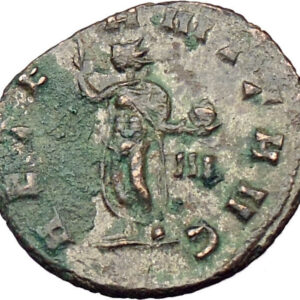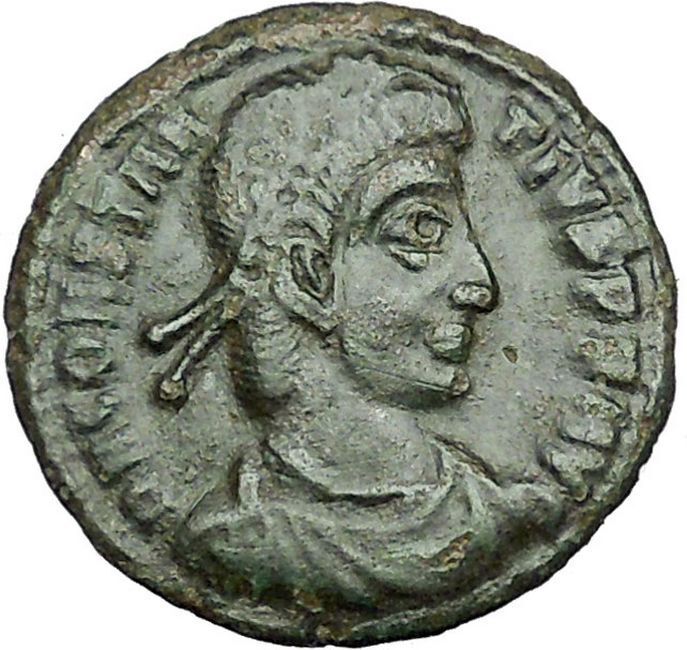|
Arcadius – Roman Emperor: 383-408 A.D.
Bronze AE2 21mm (5.16 grams) Antioch mint, struck 383-388 A.D.
D N ARCADIVS P F AVG, pearl-diademed, draped, and cuirassed bust right.
VIRTVS EXERCITI / ANTS, emperor standing right, holding labarum and globe, left foot on captive.
You are bidding on the exact item pictured, provided with a Certificate of Authenticity and Lifetime Guarantee of Authenticity.
 The labarum was a vexillum (military standard) that displayed the “Chi-Rho” symbol ☧, a christogram formed from the first two Greek letters of the word “Christ” (Greek: ΧΡΙΣΤΟΣ, or Χριστός) – Chi (χ) and Rho (ρ). It was first used by the Roman emperor Constantine I. Since the vexillum consisted of a flag suspended from the crossbar of a cross, it was ideally suited to symbolize the crucifixion of Christ. The labarum was a vexillum (military standard) that displayed the “Chi-Rho” symbol ☧, a christogram formed from the first two Greek letters of the word “Christ” (Greek: ΧΡΙΣΤΟΣ, or Χριστός) – Chi (χ) and Rho (ρ). It was first used by the Roman emperor Constantine I. Since the vexillum consisted of a flag suspended from the crossbar of a cross, it was ideally suited to symbolize the crucifixion of Christ.
Ancient sources draw an unambiguous distinction between the two terms “labarum” and “Chi-Rho”, even though later usage sometimes regards the two as synonyms. The name labarum was applied both to the original standard used by Constantine the Great and to the many standards produced in imitation of it in the Late Antique world, and subsequently.
 The Chi Rho is one of the earliest forms of christogram, and is used by some Christians. It is formed by superimposing the first two (capital) letters chi and rho (ΧΡ) of the Greek word “ΧΡΙΣΤΟΣ” = KRistos = Christ in such a way to produce the monogram. Although not technically a Christian cross, the Chi-Rho invokes the authority of Jesus, as well as symbolising his status as the Christ. The Chi Rho is one of the earliest forms of christogram, and is used by some Christians. It is formed by superimposing the first two (capital) letters chi and rho (ΧΡ) of the Greek word “ΧΡΙΣΤΟΣ” = KRistos = Christ in such a way to produce the monogram. Although not technically a Christian cross, the Chi-Rho invokes the authority of Jesus, as well as symbolising his status as the Christ.
The Chi-Rho symbol was also used by pagan Greek scribes to mark, in the margin, a particularly valuable or relevant passage; the combined letters Chi and Rho standing for chrēston, meaning “good.” Some coins of Ptolemy III Euergetes (r. 246-222 BC) were marked with a Chi-Rho.
The Chi-Rho symbol was used by the Roman emperor Constantine I (r. 306-337) as part of a military standard (vexillum), Constantine’s standard was known as the Labarum. Early symbols similar to the Chi Rho were the Staurogram (_I_193_2.jpg/20px-Christliche_Symbolik_(Menzel)_I_193_2.jpg) ) and the IX monogram ( ) and the IX monogram (_I_193_4.jpg/20px-Christliche_Symbolik_(Menzel)_I_193_4.jpg) ). ).
 Arcadius (Latin: Flavius Arcadius Augustus; Greek: Ἀρκάδιος; 1 January 377 – 1 May 408) was Byzantine Emperor from 383 to 408. He was the eldest son of Theodosius I and his first wife Aelia Flaccilla, and brother of the Western Emperor Honorius. A weak ruler, his reign was dominated by a series of powerful ministers and by his wife, Aelia Eudoxia. Arcadius (Latin: Flavius Arcadius Augustus; Greek: Ἀρκάδιος; 1 January 377 – 1 May 408) was Byzantine Emperor from 383 to 408. He was the eldest son of Theodosius I and his first wife Aelia Flaccilla, and brother of the Western Emperor Honorius. A weak ruler, his reign was dominated by a series of powerful ministers and by his wife, Aelia Eudoxia.
Arcadius was born in Hispania, the elder son of Theodosius I and Aelia Flaccilla, and brother of Honorius, who would become a Western Roman Emperor. His father declared him an Augustus and co-ruler for the Eastern half of the Empire in January 383. His younger brother was also declared Augustus in 393, for the Western half.
As emperors, Honorius was under the control of the Romanized Vandal magister militum Flavius Stilicho while Arcadius was dominated by one of his ministers, Rufinus. Stilicho is alleged by some to have wanted control of both Emperors, and is supposed to have had Rufinus assassinated by Gothic mercenaries in 395; though definite proof of Stilicho’s involvement in the assassination is lacking, the intense competition and political jealousies engendered by the two figures compose the main thread of the first part of Arcadius’ reign. Arcadius’ new advisor, the eunuch Eutropius, simply took Rufinus’ place as the power behind the Eastern imperial throne.
Arcadius was also dominated by his wife Aelia Eudoxia, who convinced her husband to dismiss Eutropius, who was holding the consulate, at the height of his power, in 399. That same year, on 13 July, Arcadius issued an edict ordering that all remaining non-Christian temples should be immediately demolished.
Eudoxia’s influence was strongly opposed by John Chrysostom, the Patriarch of Constantinople, who felt that she had used her family’s wealth to gain control over the Emperor. Eudoxia used her influence to have Chrysostom deposed in 404, but she died later that year. Eudoxia gave to Arcadius four children: three daughters, Pulcheria, Arcadia and Marina, and one son, Theodosius, the future Emperor Theodosius II.
Arcadius was dominated for the rest of his rule by Anthemius, the Praetorian Prefect, who made peace with Stilicho in the West. Arcadius himself was more concerned with appearing to be a pious Christian than he was with political or military matters, and he died, only nominally in control of his Empire, in 408.
Character and works
In this reign of a weak Emperor dominated by court politics, a major theme was the ambivalence felt by prominent individuals and the court parties that formed and regrouped round them towards barbarians, which in Constantinople at this period meant Goths. In the well-documented episode that revolved around Gainas, a number of Gothic foederati stationed in the capital were massacred, the survivors fleeing under the command of Gainas to Thrace, where they were tracked down by imperial troops and slaughtered and Gainas dispatched. The episode has been traditionally interpreted as a paroxysm of anti-barbarian reaction that served to stabilize the East. The main source for the affair is a mythology à clef by Synesius of Cyrene, Aegyptus sive de providentia, (400) an Egyptianising allegory that embodies a covert account of the events, the exact interpretation of which continues to baffle scholars. Synesius’ De regno, which claims to be addressed to Arcadius himself, contains a tirade against Goths.
A new forum was built in the name of Arcadius, on the seventh hill of Constantinople, the Xērolophos, in which a column was begun to commemorate his ‘victory’ over Gainas (although the column was only completed after Arcadius’ death by Theodosius II).
The Pentelic marble portrait head of Arcadius (now in the Istanbul Archaeology Museum) was discovered in Istanbul close to the Forum Tauri, in June 1949, in excavating foundations for new buildings of the University at Beyazit. The neck was designed to be inserted in a torso, but no statue, base or inscription was found. The diadem is a fillet with rows of pearls along its edges and a rectangular stone set about with pearls over the young Emperor’s forehead.
|





 The labarum was a vexillum (military standard) that displayed the “Chi-Rho” symbol ☧, a christogram formed from the first two Greek letters of the word “Christ” (Greek: ΧΡΙΣΤΟΣ, or Χριστός) – Chi (χ) and Rho (ρ). It was first used by the Roman emperor Constantine I. Since the vexillum consisted of a flag suspended from the crossbar of a cross, it was ideally suited to symbolize the crucifixion of Christ.
The labarum was a vexillum (military standard) that displayed the “Chi-Rho” symbol ☧, a christogram formed from the first two Greek letters of the word “Christ” (Greek: ΧΡΙΣΤΟΣ, or Χριστός) – Chi (χ) and Rho (ρ). It was first used by the Roman emperor Constantine I. Since the vexillum consisted of a flag suspended from the crossbar of a cross, it was ideally suited to symbolize the crucifixion of Christ.  The Chi Rho is one of the earliest forms of christogram, and is used by some Christians. It is formed by superimposing the first two (capital) letters chi and rho (ΧΡ) of the Greek word “ΧΡΙΣΤΟΣ” = KRistos = Christ in such a way to produce the monogram. Although not technically a Christian cross, the Chi-Rho invokes the authority of Jesus, as well as symbolising his status as the Christ.
The Chi Rho is one of the earliest forms of christogram, and is used by some Christians. It is formed by superimposing the first two (capital) letters chi and rho (ΧΡ) of the Greek word “ΧΡΙΣΤΟΣ” = KRistos = Christ in such a way to produce the monogram. Although not technically a Christian cross, the Chi-Rho invokes the authority of Jesus, as well as symbolising his status as the Christ. _I_193_2.jpg/20px-Christliche_Symbolik_(Menzel)_I_193_2.jpg) ) and the IX monogram (
) and the IX monogram (_I_193_4.jpg/20px-Christliche_Symbolik_(Menzel)_I_193_4.jpg) ).
). Arcadius (Latin: Flavius Arcadius Augustus; Greek: Ἀρκάδιος; 1 January 377 – 1 May 408) was Byzantine Emperor from 383 to 408. He was the eldest son of Theodosius I and his first wife Aelia Flaccilla, and brother of the Western Emperor Honorius. A weak ruler, his reign was dominated by a series of powerful ministers and by his wife, Aelia Eudoxia.
Arcadius (Latin: Flavius Arcadius Augustus; Greek: Ἀρκάδιος; 1 January 377 – 1 May 408) was Byzantine Emperor from 383 to 408. He was the eldest son of Theodosius I and his first wife Aelia Flaccilla, and brother of the Western Emperor Honorius. A weak ruler, his reign was dominated by a series of powerful ministers and by his wife, Aelia Eudoxia.




